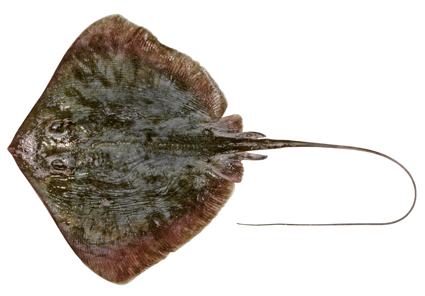Dwarf Black Stingray, Hemitrygon parvonigra Last & White 2008

A Dwarf Black Stingray, Dasyatis parvonigra. Source: CSIRO National Fish Collection. License: CC BY Attribution
Summary:
A poorly known medium-sized stingray from off north western Australia with a plain orange-brown to dark greyish-brown disc, becoming lighter towards disc margins, and paler thorns and rear of tail beyond the spine.
This species was previously known as Dasyatis pavonigra.
This species was previously known as Dasyatis pavonigra.
Cite this page as:
Bray, D.J. 2018, Hemitrygon parvonigra in Fishes of Australia, accessed 20 Apr 2024, https://fishesofaustralia.net.au/home/species/2639
Dwarf Black Stingray, Hemitrygon parvonigra Last & White 2008
More Info
|
Distribution |
Known from off northwestern Australia. Elsewhere the species occurs in Indonesia, Malaysia and perhaps the Philippines and West Papua in Southeast Asia. |
|
Features |
Disc diamond-shaped, slightly wider than long, with rather angular outer corners and nearly straight anterior corners. Snout broadly triangular, with a pointed tip; eyes large, elevated, followed immediately by larger spiracles; a wide, skirt-shaped curtain of skin with a minutely fringed posterior margin between the short, oval nostrils; medium-sized mouth strongly arched with four papillae across the floor and an additional, tiny papilla near the corner of each jaw. Teeth small, approx 43 rows in both jaws; teeth near symphysis with long, thin cusps, those near outer corners with very low crowns. Five pairs of lightly S-shaped gill slits. Pelvic fins small with nearly straight margins; males with rather flattened claspers. The tail measures around 1.5 times as long as the disc and is relatively broad and flattened at the base. One, rarely two serrated stinging spines are dorsally placed about a third of a disc width back from the tail base. Beyond the sting, the tail becomes thin and whip-like, bearing a long, low ventral fin fold and a much shorter dorsal ridge. There is a short row of closely spaced, spear-shaped thorns along the midline of the back, starting behind the head; 1–2 small, seed-shaped thorns are also present on each "shoulder". |
|
Size |
To 51 cm DW (disc width), and 110 cm TL. |
|
Colour |
Plain orange-brown to dark greyish-brown above, becoming lighter towards disc margins, white below, thorns and rear of tail beyond the spine lighter. |
|
Fisheries |
Taken as incidental bycatch in commercial trawl fisheries in parts of its range. |
|
Etymology |
The specific name parvonigra is from the Latin parvus meanign 'little' and nigra meaning 'black, in reference to the superficial resemblance of the Dwarf Stingray to the much larger black stingray, Dasyatis thetidis. |
|
Species Citation |
Dasyatis parvonigra Last & White, 2008, CSIRO Mar. Atmosph. Res. Pap. 022: 276. Type locality: north of Cape Lambert, WA [19°06'S,117°09'E]. |
|
Author |
Bray, D.J. 2018 |
|
Resources |
Dwarf Black Stingray, Hemitrygon parvonigra Last & White 2008
References
Last, P.R., Naylor, G.J.P. & Manjaji-Matsumoto, B.M. 2016. A revised classification of the family Dasyatidae (Chondrichthyes: Myliobatiformes) based on new morphological and molecular insights. Zootaxa 4139(3): 345–368. DOI: http://dx.doi.org/10.11646/zootaxa.4139.3.2 Abstract
Last, P.R., Manjaji-Matsumoto, B.M., Naylor, G.J.P. & White, W.T. 2016. Family Dasyatidae pp. 522-618. In: Last, P.R., White, W.T., de Carvalho, M.R., Séret, B., Stehmann, M.F.W. & & Naylor, G.J.P. (eds) Rays of the World. Melbourne: CSIRO Publishing, 800 pp.
Last, P.R. & Stevens, J.D. 1994. Sharks and Rays of Australia. Canberra : CSIRO Australia 513 pp. 84 pls. (p. 384, as Dasyatis sp A)
Last, P.R. & Stevens, J.D. 2009. Sharks and Rays of Australia. Collingwood : CSIRO Publishing Australia 2, 550 pp. (as Dasyatis parvonigra)
Last, P.R. & White, W.T. 2008. Dasyatis parvonigra sp. nov., a new species of stingray (Myliobatoidei: Dasyatidae) from the tropical eastern Indian Ocean. 275-282 in Last, P.R., White, W.T. & Pogonoski, J.J. (eds). Descriptions of new Australian chondrichthyans. CSIRO Marine and Atmospheric Research Paper No. 022: 1-358.
Last, P.R., White, W.T., Caira, J.N., Dharmadi, Fahmi, Jensen, K., Lim, A.P.K., Manjaji-Matsumoto, B.M., Naylor, G.J.P., Pogonoski, J.J., Stevens, J.D. & Yearsley, G.K. 2010. Sharks and Rays of Borneo. CSIRO Marine and Atmospheric Research, Collingwood.(as Dasyatis parvonigra)
Pierce, S.J. 2016. Hemitrygon parvonigra. The IUCN Red List of Threatened Species 2016: e.T195442A104121791. http://dx.doi.org/10.2305/IUCN.UK.2016-3.RLTS.T195442A104121791.en. Downloaded on 11 July 2018.

